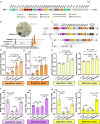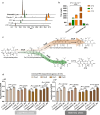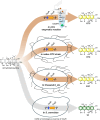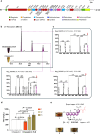Development of a versatile chassis for the efficient production of diverse type II polyketides
- PMID: 40781232
- PMCID: PMC12334735
- DOI: 10.1038/s41467-025-62659-0
Development of a versatile chassis for the efficient production of diverse type II polyketides
Abstract
Type II polyketides (T2PKs) exhibit a wide range of structural diversity and potent pharmacological activities. However, the optimal chassis for the synthesis of T2PKs remains elusive, impeding the effective mining and production of these compounds. In this study, we identify Streptomyces aureofaciens J1-022, a high-yield producer of chlortetracycline, as a promising chassis for T2PKs synthesis. To mitigate precursor competition, we execute an in-frame deletion of two endogenous T2PKs gene clusters, resulting in a pigmented-faded host, designated Chassis2.0. Compared to conventional Streptomyces chassis, Chassis2.0 demonstrates enhanced efficiency in the production of oxytetracycline, achieving a 370% increase relative to commercial production strains. Additionally, the tri-ring type T2PKs, which includes actinorhodin and flavokermesic acid, are synthesized in Chassis2.0 with high efficiency. Furthermore, an unidentified biosynthetic gene cluster (BGC) associated with pentangular T2PKs is directly activated, leading to the production of a structurally distinct TLN-1. In conclusion, we successfully achieve the efficient synthesis of tri-ring type pigmented products, the overproduction of tetra-ring antibiotics, and the discovery of penta-ring type polyketides in Chassis2.0. These findings underscore the potential of Chassis2.0 as an optimal platform for the discovery and overproduction of T2PKs.
© 2025. The Author(s).
Conflict of interest statement
Competing interests: The authors declare no competing interests.
Figures







Similar articles
-
Discovery of Tricyclic Aromatic Polyketides Reveals Hidden Chain-Length Flexibility in Type II Polyketide Synthases.Int J Mol Sci. 2025 Aug 13;26(16):7801. doi: 10.3390/ijms26167801. Int J Mol Sci. 2025. PMID: 40869122 Free PMC article.
-
A highly efficient heterologous expression platform to facilitate the production of microbial natural products in Streptomyces.Microb Cell Fact. 2025 May 14;24(1):105. doi: 10.1186/s12934-025-02722-z. Microb Cell Fact. 2025. PMID: 40369635 Free PMC article.
-
Genome mining identifies a diversity of natural product biosynthetic capacity in human respiratory Corynebacterium strains.mSphere. 2025 Jun 25;10(6):e0025825. doi: 10.1128/msphere.00258-25. Epub 2025 May 21. mSphere. 2025. PMID: 40396729 Free PMC article.
-
Progress on the construction of Streptomyces minimized genomes.Yi Chuan. 2025 Jul 20;47(7):756-767. doi: 10.16288/j.yczz.25-008. Yi Chuan. 2025. PMID: 40675762 Review.
-
Exploring pigment-producing Streptomyces as an alternative source to synthetic pigments: diversity, biosynthesis, and biotechnological applications. A review.World J Microbiol Biotechnol. 2025 Jun 25;41(7):211. doi: 10.1007/s11274-025-04379-7. World J Microbiol Biotechnol. 2025. PMID: 40555885 Review.
References
-
- Hertweck, C. et al. Type II polyketide synthases: gaining a deeper insight into enzymatic teamwork. Nat. Prod. Rep.24, 162–190 (2007). - PubMed
-
- Meloan, S. N. et al. On the structure of carminic acid and carmine. Histochemie27, 87–95 (1971). - PubMed
-
- Ferreyra-Suarez, D. et al. Extraction pathways and purification strategies towards carminic acid as natural-based food colorant: A comprehensive review. Adv. Colloid Interface Sci.323, 103052 (2024). - PubMed
-
- Aubel-Sadron, G. & Londos-Gagliardi, D. Daunorubicin and doxorubicin, anthracycline antibiotics, a physicochemical and biological review. Biochimie66, 333–352 (1984). - PubMed
MeSH terms
Substances
Grants and funding
LinkOut - more resources
Full Text Sources
Miscellaneous

